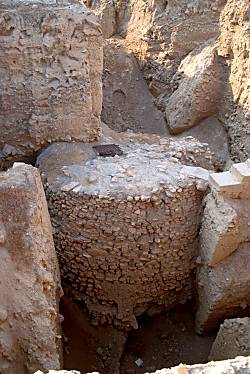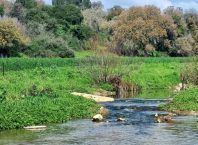Jericho, 1956
It is a blistering hot day in Jericho, one of the hottest thus far in this summer of 1956. The temperature at midday registered at just a hair’s breadth below the 100 degree mark on the Fahrenheit thermometer nailed to the director’s tent. The mercury will certainly rise above that this afternoon. It is perfectly dreadful weather for any kind of archaeology. Skin-burning, eye-searing, hot blazing sunlight; withering heat; dust rising in choking clouds from the dry, sun-scorched earth; heat rising in shimmering waves from all points of the horizon. And, as though these and a thousand other discomforts were somehow not enough, there are the inevitable swarms of aggressive Near Eastern flies—landing everywhere: on food, drink, open cuts and bruises, as well as eyes, nostrils and open mouths. Summer in the Holy Land. Still, it is better than trying to dig here in the Levantine winter, with its sudden drenching cold rains turning the ground to muck.
This is their fifth season at Jericho. They have been digging here since 1952, under the direction of Dr., and later Dame, Kathleen Kenyon, director of the British School of Archaeology in Jerusalem. They will continue to dig here until 1958, after which Professor Kenyon will write a virtual five-foot shelf of books and articles about the archaeology of the Holy Land, as well as numerous articles in newspapers and magazines attacking the young State of Israel, damning Zionism, and expressing her fervent belief that Palestine belongs to the Arabs.
Her mind is not on politics, however, on this oppressively hot day in 1956. She is, at this moment, sitting in her tent sipping a cup of lukewarm tea, vaguely conscious of a growing murmur of voices coming from Trench 1, her main excavation pit, a short distance away. Kenyon, herself the daughter of a noted Bible lands archaeologist, is remembering her first look at the archaeological site, less than a mile away from the modern town of Jericho. On the day she arrived, those four long years ago, she saw a hill around 70 feet high. Whereas many ancient cities in this part of the world had been built on hilltops, Kenyan duly expected to find Ancient Jericho buried somewhere beneath the surface of the top of the hill. As she watched Arab workmen dig her initial test trench, however, she soon became aware that the entire hill was “Ancient Jericho,” an enormous mound made of layer upon layer of remains deposited in turn by one ancient civilization after another, one on top of another—the earliest below, the progressively more recent above. Some of the trenches they had already dug actually went down from the latest periods of the mound’s occupation through Herodian, Hasmonean, Biblical Israelite, Canaanite, and Bronze Age remains, right down to the base of the mound—level with the surrounding plain—to the earliest phase of the Neolithic, or New Stone Age. Kenyon’s team had discovered evidence of the world’s earliest known full-time human settlement at the mound’s lowest layer. These remains were from a time when wandering bands of hunters began to give up nomadic hunting and food gathering, settle in one place, build primitive mud brick houses, and make the first tentative attempts at planting and growing wild forms of wheat.
And now, as Kenyon sits in her swelteringly hot tent, scowling over her field notes and drinking the last of her tea, her mind begins to focus on the chorus of voices coming from Trench 1, which have risen from a murmur to an annoying cacophony of excited chatter in very guttural Arabic. Imagining some sort of quarrel or problem among the workmen, she sighs, girds herself for trouble and leaves her tent. What greets her as she makes her way to Trench 1 is not trouble but sudden intense fascination. The workmen at the top of the trench are pointing down toward something being dug out by the workmen at the bottom. As the buckets of dirt continue to rise from the digging below, and as the vague shape of whatever is being dug out becomes clearer, Kenyon blinks and rubs her eyes to make sure she is actually seeing what she thinks she is seeing. As the sound of spades scraping against dirt hardened by thousands of years of impacted burial seems to become more urgent, the minds of Kenyon’s assistants begin to tell them that what their eyes are seeing simply cannot be.
For there, at this lowest level of permanent human settlement—dating from around the year 8000 BC—stands something that is beyond extraordinary. There, surrounded by the remains of the most primitive mud brick houses imaginable, stands what appears to be a large round building made of stone. As the digging continues, it slowly becomes increasingly evident that the building had been some sort of tower, constructed inside of some kind of stone wall. In the midst of mankind’s earliest permanent settlement, inhabited by people who were just beginning to build permanent houses and experiment with agriculture, stood a piece of monumental architecture, made of stone, and erected thousands of years before its time.
The workmen become more excited and a profound hush falls upon an amazed Kathleen Kenyon and her team of archaeologists as they watch the afternoon sunlight begin to hit the newly-exposed stones of the tower. And, like everything else in this sun-drenched part of the world, the stones of the large round tower begin once again to catch the sun’s rays and glow brightly in the dazzling daylight, just as they had done every sunny day almost 10,000 years ago.
Jericho, 8000 BC
The end of the last Ice Age led to profound changes to the Earth and its primitive inhabitants. The retreat of the glaciers brought changes in climate, the disappearance of large herds of game animals, the appearance of new species of wild plants, and a new range of challenges and opportunities for the children and grandchildren of Ice Age hunters. People now began to develop news ways of living, of getting food, and of organizing themselves into more stable communities. They began to develop new technologies to hunt the now plentiful small game in surrounding forests, catch fish in nearby rivers, and harvest wild grains from the general vicinity in which they lived. This was a period of transition in human history, and anthropologists call it the Mesolithic, or the Middle Stone Age—interposed between the former hunting and gathering Paleolithic, or Old Stone Age; and the agricultural Neolithic, or New Stone Age soon to dawn.
Archaeologists call the people who lived through this period in what is now Israel, Jordan, Lebanon and Syria “Natufians,” named after Wadi en-Natuf, the archaeological site north of present-day Modi’in Ilit, where the remains of these forgotten people were first identified and studied. From 11,000 BC onward, groups of these people gradually began to stop wandering all year round and spend increasing amounts of time in one place, exploiting the local resources. And what resources there were to exploit! In those long ago days of the Mesolithic, the Levant was not the dry, thorny place it later became, but rather a lush woodland of pristine forests and rolling parkland, a land indeed flowing with milk and honey.
Like other Mesolithic people, the Natufians tossed away the spears their Ice Age ancestors had used to bring down large animals and developed the bow and arrow to hunt small game. The fine “microlithic” arrow heads they skillfully made for this purpose were as much works of art as deadly weapons. To catch fish in nearly ponds and rivers, they fashioned cleaver fish hooks and other utensils made of bone. And to best take advantage of the rich stands of wild cereal grains like wheat and barley, they made grinding stones as these grains became an ever more important part of their diet.
One group of these Natufians, consisting of around 200 people, began to settle seasonally or semi-permanently at a cozy little spot at the western edge of the Jordan valley. We have no idea what kind of language these people spoke or what they called their new home—if indeed they called it anything at all. Much, much later, in times recorded in history, the place would be known as Jericho. Most likely, the people were attracted by a perpetual spring of clean, fresh water (producing 4,4 cubic meters per minute). They were certainly drawn by an abundance of wild grain, judging from the number of grinding stones or “querns” found at the lowest levels of the site.
Then, around 8500 BC or thereabouts, these Natufians at Jericho began to build permanent houses which they lived in year-round, and to grow their own wheat instead of relying on the vagaries of nature. Thus began the Neolithic period of human development, marked by the invention of agriculture. The seasonal Natufian camp had now become an early farming village—perhaps the world’s first. As the making of pottery would not begin for another three thousand years, archaeologists call this period of Jericho the Pre-Pottery Neolithic, Phase A—or “PPNA” for short.
Thus PPNA Jericho grew and prospered. The village became a dense cluster of mud brick houses, with no streets or plan. Houses were oval or circular, around 14 feet in diameter, with inward-leaning walls and sunken mud plaster floors. Population estimates range anywhere from around 400 to 2,000 inhabitants, with each family very much like every other. No one was specialized, nor does there seem to have been any appreciable differences in wealth or social standing. Each family appears to have supplied most of its own needs, and each house had its own bin for storing grain.
Then, around 8000 BC, after some 500 years of stable, settled farming life, the people of PPNA Jericho did something no one else in the world had ever done before. Without any known precedent, they built a wall around their village. The wall was made of stacked stones, six feet think at the base and 13 feet high. It was actually higher than that; an unknown amount of this first wall eroded away thousands of years ago.
But it was what these people built just inside the wall that fascinates and intrigues us today. For whatever reason, for the first time in human history, these early villagers erected a circular stone tower, some 30 feet in diameter, and 27 feet high. A doorway at the base of the tower opened into a flight of stairs (the world’s first staircase?) leading to the roof. The walls inside of the tower were made smooth with plastered mud. The top of the tower no doubt commanded a panoramic view of the surrounding countryside that extended all the way to the horizon in ever direction. As well it might have. The tower was, at that moment, almost certainly the tallest building on Earth.
The round stone tower of PPNA Jericho was also the world’s first stone building, its first public building, and its first work of monumental architecture. It was, of course, quite modest compared to Egypt’s pyramids, but Jericho’s tower had stood for more than 5000 years—much of those buried and forgotten—before the first stone of the first pyramid was laid. In its day, the tower was doubtlessly a landmark visible for many miles across the surrounding plain, its stones aglow in the afternoon sunlight, reaching higher toward the sky than people had ever built before. Today, we look down upon what remains of this curious structure, rising from the bottom of an archaeological trench.
Holy Land, 2009
Professor Kathleen Kenyon, renowned Biblical archaeologist, was something of a disappointment to literal believers of the Bible. Throughout her well-publicized excavations at Jericho, these people were eagerly waiting for her archaeological findings to validate their religious beliefs. Especially betrayed were those who wanted Kenyon to say that the wall she found at PPNA Jericho “proved” the story of the Walls of Jericho as related in the Book of Joshua. To her dying day, however, she would insist that the wall she had found had been abandoned, buried and forgotten for more than 6,000 years before the Israelite conquest of Canaan at around 1200 BC, and that there had been no wall around Jericho at that time.
Others, including many of her fellow archaeologists, were disappointed at Kenyon’s unwillingness to state definitively what the wall and tower had been built for, and what function it had served. Archaeologists today are divided between those who say that the wall and tower were built to protect the village against floods, and those who argue that they were built for defense, to protect the village against other people.
Flooding does seem to have been a major problem, according to the evidence. One excavation trench that was not near the wall exposed a gully almost 5 feet deep from a stream of flood water and silt that had flown through the village. Evidence suggests that the gully had eroded and silted up at least three times in the course of its existence. Archaeologists who favor this flood protection theory for the wall note that there is no evidence of any kind of warfare at PPNA Jericho. The place was finally abandoned for a short time, but for reasons unknown.
Proponents of the defense theory ask why a wall so high was needed just to protect against floods, and why a tower was needed at all. Their best argument, however, is the sheer scale of the undertaking, building this wall and tower. PPNA Jericho did not have a large population. Nor is there evidence for any kind of political hierarchy or social class structure at this time. Everyone seems to have been independent, self-sufficient and equal. No one appears to have been exalted or powerful enough to tell anyone to do anything. What then could have induced these people to invest the time and sweat needed to build a 13 foot high stone wall around the village and a 27 foot high stone tower? The defense theorists answer in one word: fear. The construction of the wall and tower was driven, they say, by a serious fear of attack by powerful enemies. And who might these enemies have been? Most likely, they were the people who occupied the site later, built their larger rectangular houses on the ruins of the smaller circular houses of Pre-Pottery Neolithic A, and became the people whom archaeologists call Pre-Pottery Neolithic B.
If that is indeed what happened, and the defense theorists are right, then it is obvious that whatever it is about this beautiful land that has driven insane the people of one civilization after another was already here, in those primeval days, working its devilment in the hearts and minds of those who lived at civilization’s dawn.
CARL HOFFMAN







wish more
awsome
Just stumbled across this website and this was a most interesting piece and a great read. Ronnie’s comment says much of what I worked out for myself while reading this piece.
A fascinating piece, Carl, thank you.
If there is one lesson to be learned from this it is that looking to archaeology to prove the veracity – or otherwise – of inspired writings is much like trusting thin ice to bear the weight of an elephant.
Religious faith does not spring from archaeological or other scientific discoveries but on divine inspiration.
Whatever is or is not unearthed by brush and trowel should neither confirm nor disturb a believer’s faith in God. Science is not the enemy of religion, and vice versa.
It is sad that so much time, effort, and money is spent by certain believers to convince the world that archaeology proves this or that when religious faith does not depend on artefacts, theories, or physical evidence for its place in the human soul.
The stone tower and wall in reference was built by the Anunnuki(The Gods and creator of mankind from the planet Nibiru)and was used as a spaceport ” The stairway to Heaven” as described by Sumerian texts, there was also a Silo used for transport in Egypt, around 2860 B.C.E.
These were the first structures built on earth and the tower survived the great deluge within that same period. The genesis of humankind has evolved through and with interbreeding of Anunnuki and their creation. The time period that their planet was within our constellation was some 3600 years ago, and is predicted to to be here again 2012. Read Zacharia Sitchin ” The End Of Days “.
Correspondingly, there are also predictions (Many of which have already happened)that worldwide natural disasters will occur in great frequency. So,we must pray our Gods will understand the mess we have created.
Very interesting article Carl. Thanks.
Comments are closed.